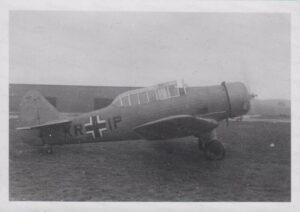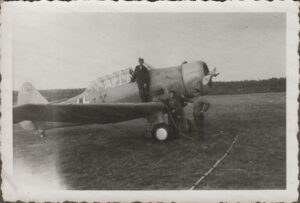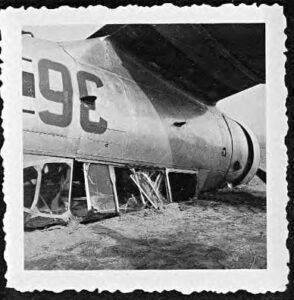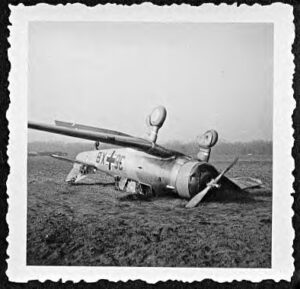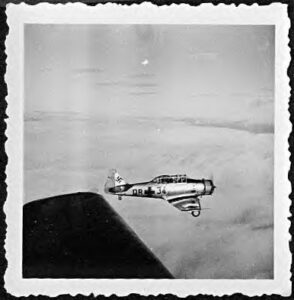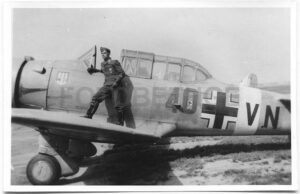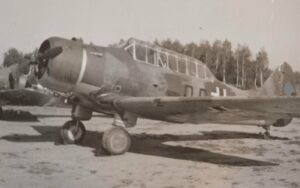𝕲𝖊𝖗𝖒𝖆𝖓 𝕷𝖚𝖋𝖙𝖜𝖆𝖋𝖋𝖊
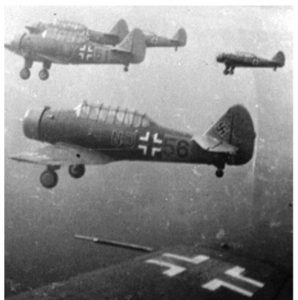 The NA-64 P-2 was built for the French Armée de l’Air and Aéronavale in 1939–1940, which ordered 200 and 30 respectively. Of these, 111 had been delivered before France surrendered to the Germans after the Battle of France. In France, the NA-64, like the NA-57 before it, designated as NAA-64 P-2 (abbreviated from North American Aviation modèle 64 perfectionnement, 2 places (North American Aviation model 64 advanced trainer, 2 seats) but were sometimes attached to reconnaissance units. A small number escaped the Germans to be used by the Vichy French Air Force. Two examples in North Africa survived into the postwar years, having been operated alongside NA-57s, the last only retired in 1949.
The NA-64 P-2 was built for the French Armée de l’Air and Aéronavale in 1939–1940, which ordered 200 and 30 respectively. Of these, 111 had been delivered before France surrendered to the Germans after the Battle of France. In France, the NA-64, like the NA-57 before it, designated as NAA-64 P-2 (abbreviated from North American Aviation modèle 64 perfectionnement, 2 places (North American Aviation model 64 advanced trainer, 2 seats) but were sometimes attached to reconnaissance units. A small number escaped the Germans to be used by the Vichy French Air Force. Two examples in North Africa survived into the postwar years, having been operated alongside NA-57s, the last only retired in 1949.
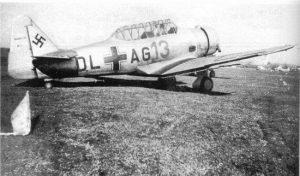
During the interwar period, German pilots were trained secretly to violate the treaty at Lipetsk Air Base in the Soviet Union. With the rise of the Nazi Party and the Versailles Treaty’s repudiation, the Luftwaffe‘s existence was publicly acknowledged on 26 February 1935, just over two weeks before open defiance of the Versailles Treaty through German re-armament and conscription would be announced on 16 March. The Condor Legion, a Luftwaffe detachment sent to aid Nationalist forces in the Spanish Civil War, provided the force with a valuable testing ground for new tactics and aircraft. Partially due to this combat experience, the Luftwaffe had become one of the most sophisticated, technologically advanced, and battle-experienced air forces in the world when World War II broke out in 1939. By the summer of 1939, the Luftwaffe had twenty-eight Geschwader (wings). The Luftwaffe also operated Fallschirmjäger paratrooper units.
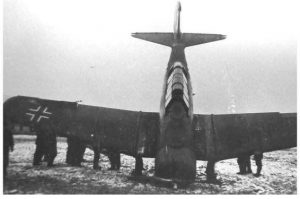 The Treaty of Versailles, signed on 28 June 1919, prohibited Germany from operating any form of air force after losing the First World War. Initially, it also prohibited the production and import of any form of aircraft to the country. In 1922, the clause on civilian aircraft was dropped, and Germany was able to produce planes again, followed in 1923 with the country regaining control of its airspace. The operation or production of aircraft for military means was, however, still prohibited.
The Treaty of Versailles, signed on 28 June 1919, prohibited Germany from operating any form of air force after losing the First World War. Initially, it also prohibited the production and import of any form of aircraft to the country. In 1922, the clause on civilian aircraft was dropped, and Germany was able to produce planes again, followed in 1923 with the country regaining control of its airspace. The operation or production of aircraft for military means was, however, still prohibited.
The often unseen and unrecognised element in aerial warfare is training the pilots and crews, yet its value is beyond calculation. In this fundamental role, a wide variety of aircraft was used by the Luftwaffe, with trainee pilots progressing from simpler, older machines, such as the Klemm 35, the Focke-Wulf Fw 44 and the Bücker 131, to the more sophisticated Arado Ar 66, the Gotha Go 145 and the Arado Ar 76, as well as heavier aircraft like the Junkers W33 and W44. Gradually they would be introduced to newer and faster models that enabled them to experience, to some degree, the type of aircraft they would be flying in combat.
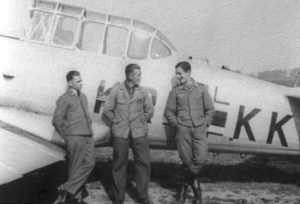 Recruits would initially spend six months at a Fliegerersatzabteilung or training depot. The main emphasis was on drill and physical training, with introductory lectures on wireless operation principles and map reading. This would be followed by two months studying general aeronautical subjects before being sent to elementary flying school.
Recruits would initially spend six months at a Fliegerersatzabteilung or training depot. The main emphasis was on drill and physical training, with introductory lectures on wireless operation principles and map reading. This would be followed by two months studying general aeronautical subjects before being sent to elementary flying school.
The various kinds of aircraft used for training depended upon the role each trainee would eventually undertake, from single-seat fighters to multiple-crew bombers or transports. For example, those men ear-marked to become bomber pilots trained on early versions of He 111, the Ju 52, Ju 86 and the Do 17. In this, the Luftwaffe was also able to make use of captured enemy aircraft. It also established training units through the Occupied territories to enable its trainees to familiarise themselves with different conditions and terrain.
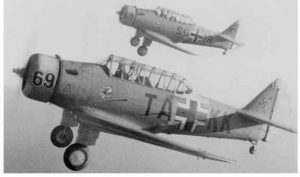 One of the reasons that the Luftwaffe performed so well in the early years of the War was a very effective pilot training program. This began early, even before the Luftwaffe was created. A Hitler Youth unit air unit was formed–the Flieger HJ. Boys began learning about how to build gliders and fly them. As a result, when the Luftwaffe was created, there was already a sizeable body of young people with a basic familiarity with flying. When the Luftwaffe was created, older Hitler Youth (HJ) boys were funnelled into the military. As part of the Hilter Youth program, a boy could select specific services, and one of the options was the Flieger HJ which prepared boys for Luftwaffe service. The early German victories were not solely due to better aircraft types and a larger force. The Luftwaffe also had an enormous advantage of well-trained pilots with a well-defined tactical doctrine. There was, however, only one pilot training school. Like the Wehrmacht, the Luftwaffe was built around a strategic doctrine of campaigns against individual countries that could be quickly overwhelmed.
One of the reasons that the Luftwaffe performed so well in the early years of the War was a very effective pilot training program. This began early, even before the Luftwaffe was created. A Hitler Youth unit air unit was formed–the Flieger HJ. Boys began learning about how to build gliders and fly them. As a result, when the Luftwaffe was created, there was already a sizeable body of young people with a basic familiarity with flying. When the Luftwaffe was created, older Hitler Youth (HJ) boys were funnelled into the military. As part of the Hilter Youth program, a boy could select specific services, and one of the options was the Flieger HJ which prepared boys for Luftwaffe service. The early German victories were not solely due to better aircraft types and a larger force. The Luftwaffe also had an enormous advantage of well-trained pilots with a well-defined tactical doctrine. There was, however, only one pilot training school. Like the Wehrmacht, the Luftwaffe was built around a strategic doctrine of campaigns against individual countries that could be quickly overwhelmed.
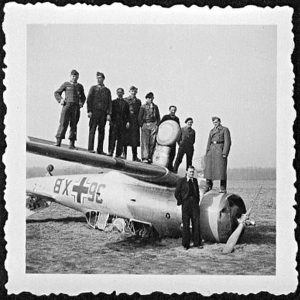 No one imagined that the Führer would take on not only the British and French but without completing the war in the West, the Soviet Union and the United States as well. One pilot training school might have sufficed with the British and French, but not when the Soviet Union and the United States were added to Germany’s foes. Successes in the first 2 years of the War did not lead Luftwaffe planners to question this assessment. Hitler, by December 1941, however, had involved Germany with a potent coalition including America, Britain, and the Soviet Union with enormous industrial and scientific resources. The German advantage dissipated as the War continued. The Americans and British turned out ever larger numbers of competent aircrews. The Luftwaffe, unlike the Americans, kept their aces in combat until they were killed or wounded. This meant in practice that hard-won battle skills were constantly drained from the Luftwaffe. American practice was to bring back the most effective pilots after a tour of duty to train new pilots. Incredibly, the Luftwaffe did not open new pilot schools until 1944. At first, they modified the pilot training program to push more pilots through more quickly. Besides the limited capacity, the Luftwaffe training program failed to make use of the expertise of fighter aces. They were kept on station until they were killed or wounded. This is one reason that German aces racked up higher scores than Allied aces who were rotated. This had predictable results. Not only were cadets lost in the training program, but the new pilots produced had to face effectively trained Allied pilots in increasingly capable aircraft. The Luftwaffe training program by 1944 was severely impaired by increasing shortages of aviation fuel. There were still places available in the last phase of the War, but the Luftwaffe had difficulty finding competent pilots. During the Battle of Britain, the RAF had to send out pilots with minimal training–many of who did not survive their first few sorties. By the end of the War, the Luftwaffe was throwing pilots into battle with minimal training.
No one imagined that the Führer would take on not only the British and French but without completing the war in the West, the Soviet Union and the United States as well. One pilot training school might have sufficed with the British and French, but not when the Soviet Union and the United States were added to Germany’s foes. Successes in the first 2 years of the War did not lead Luftwaffe planners to question this assessment. Hitler, by December 1941, however, had involved Germany with a potent coalition including America, Britain, and the Soviet Union with enormous industrial and scientific resources. The German advantage dissipated as the War continued. The Americans and British turned out ever larger numbers of competent aircrews. The Luftwaffe, unlike the Americans, kept their aces in combat until they were killed or wounded. This meant in practice that hard-won battle skills were constantly drained from the Luftwaffe. American practice was to bring back the most effective pilots after a tour of duty to train new pilots. Incredibly, the Luftwaffe did not open new pilot schools until 1944. At first, they modified the pilot training program to push more pilots through more quickly. Besides the limited capacity, the Luftwaffe training program failed to make use of the expertise of fighter aces. They were kept on station until they were killed or wounded. This is one reason that German aces racked up higher scores than Allied aces who were rotated. This had predictable results. Not only were cadets lost in the training program, but the new pilots produced had to face effectively trained Allied pilots in increasingly capable aircraft. The Luftwaffe training program by 1944 was severely impaired by increasing shortages of aviation fuel. There were still places available in the last phase of the War, but the Luftwaffe had difficulty finding competent pilots. During the Battle of Britain, the RAF had to send out pilots with minimal training–many of who did not survive their first few sorties. By the end of the War, the Luftwaffe was throwing pilots into battle with minimal training.
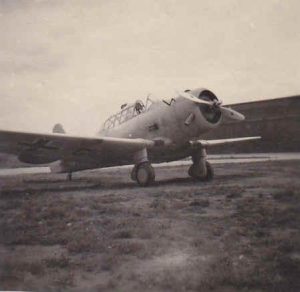 Early Luftwaffe Training Program
Early Luftwaffe Training Program
One of the reasons that the Luftwaffe performed so well in the early years of the War was a very effective pilot training program. This began early, even before the Luftwaffe was created. A Hitler Youth unit air unit was formed–the Flieger HJ. Boys began learning about how to build gliders and fly them. As a result, when the Luftwaffe was created, there was already a sizeable body of young people with a basic familiarity with flying. When the Luftwaffe was created, older Hitler Youth (HJ) boys were funnelled into the military.
Strategic Concept
The early German victories were not solely due to better aircraft types and a larger force. The Luftwaffe also had an enormous advantage of well-trained pilots with a well-defined tactical doctrine. There was, however, only one pilot training school. Like the Wehrmacht, the Luftwaffe was built around a strategic doctrine of campaigns against individual countries that could be quickly overwhelmed. No one imagined that the Führer would take on not only the British and French but without completing the war in the West, the Soviet Union and the United States as well. One pilot training school might have sufficed with the British and French, but not when the Soviet Union and the United States were added to airforces the Luftwaffe had to face.
Demand on the Luftwaffe
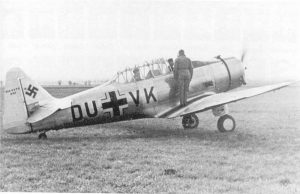 Successes in the first 2 years of the War did not lead Luftwaffe planners to question this assessment. Hitler, by December 1941, however, had involved Germany with a potent coalition including America, Britain, and the Soviet Union with enormous industrial and scientific resources. The Luftwaffe succeeded in largely destroying the enormous Red Air Force at the onset of Barbarossa (June 1941). Many of the aircraft were destroyed on the ground, meaning that the pilots survived. And the Soviets moved aircraft plants beyond the Urals. And when the Red Army stopped the Wehrmacht before the Moscow (December 1941), I gave the Red Air Force time to begin to reorganize and for the aircraft plants to come back online. Simultaneously, British aircraft plants continued to crank out aircraft, including the iconic Avro Lancaster. German industry did not have the capacity to produce heavy four-engine strategic bombers; the British did. And even more importantly, after Hitler declared war on America (December 1941), the American industry was not only fully mobilized but expanded faster and beyond all expectations of the Axis or even many Allied planers. The initial German advantage rapidly dissipated as the War continued. The Americans and British turned out ever larger numbers of competent aircrews.
Successes in the first 2 years of the War did not lead Luftwaffe planners to question this assessment. Hitler, by December 1941, however, had involved Germany with a potent coalition including America, Britain, and the Soviet Union with enormous industrial and scientific resources. The Luftwaffe succeeded in largely destroying the enormous Red Air Force at the onset of Barbarossa (June 1941). Many of the aircraft were destroyed on the ground, meaning that the pilots survived. And the Soviets moved aircraft plants beyond the Urals. And when the Red Army stopped the Wehrmacht before the Moscow (December 1941), I gave the Red Air Force time to begin to reorganize and for the aircraft plants to come back online. Simultaneously, British aircraft plants continued to crank out aircraft, including the iconic Avro Lancaster. German industry did not have the capacity to produce heavy four-engine strategic bombers; the British did. And even more importantly, after Hitler declared war on America (December 1941), the American industry was not only fully mobilized but expanded faster and beyond all expectations of the Axis or even many Allied planers. The initial German advantage rapidly dissipated as the War continued. The Americans and British turned out ever larger numbers of competent aircrews.
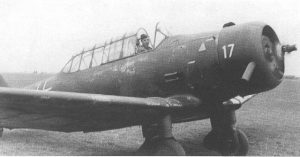 Unlike the American Air Force and Navy, the Luftwaffe kept their aces in combat until they were killed or wounded. The Luftwaffe pilots performed phenomenally in the War. The German aces ran up such large kill numbers, and there were so many German aces. Major Erich Hartmann, top Luftwaffe ace, was credited with an incredible 352 victories. There were 35 German pilots credited with more than 150 kills and even more with 100 kills. These numbers are much larger than those achieved by the Western Allies, whose top aces had only about 40 kills. The top Soviet ace had some 60 kills. These numbers have led to controversy. Some authors claim that the Luftwaffe tallies were absurdly inflated. This isn’t easy to assess. This may be part of the reason, but there are other matters as well. The Luftwaffe, at the beginning of the war, was the premier air force in the world. They were well trained, had excellent planes, an effective tactical doctrine, and Hitler’s intervention in Spain had actual combat experience. They faced the air forces at the onset of the War had either obsolete planes or poorly trained pilots and ineffective tactical doctrine. The Battle of Britain was a rare exception to a string of Luftwaffe victory.
Unlike the American Air Force and Navy, the Luftwaffe kept their aces in combat until they were killed or wounded. The Luftwaffe pilots performed phenomenally in the War. The German aces ran up such large kill numbers, and there were so many German aces. Major Erich Hartmann, top Luftwaffe ace, was credited with an incredible 352 victories. There were 35 German pilots credited with more than 150 kills and even more with 100 kills. These numbers are much larger than those achieved by the Western Allies, whose top aces had only about 40 kills. The top Soviet ace had some 60 kills. These numbers have led to controversy. Some authors claim that the Luftwaffe tallies were absurdly inflated. This isn’t easy to assess. This may be part of the reason, but there are other matters as well. The Luftwaffe, at the beginning of the war, was the premier air force in the world. They were well trained, had excellent planes, an effective tactical doctrine, and Hitler’s intervention in Spain had actual combat experience. They faced the air forces at the onset of the War had either obsolete planes or poorly trained pilots and ineffective tactical doctrine. The Battle of Britain was a rare exception to a string of Luftwaffe victory.
 German pilots ran up their kills during this period, but the onset of Barbarossa turned them loose on the huge Red Air Force with many obsolete aircraft and, thanks to Stalin, was largely on the ground when the Germans struck. So it is very likely that large numbers of German pilots had very substantial kills to their credit, although we can not speak to the precise numbers reported. Along with these kill tallies came an enormous amount of combat experience. The German practice of keeping their aces in combat meant hard-won battle skills were constantly drained from the Luftwaffe as the war progressed. This was especially the case as the Luftwaffe faced increasingly large numbers of effective, high-performance Allied planes operated by well-trained pilots. The American practice was to bring back the most effective pilots after a tour of duty to help train new pilots, providing the trainee pilots with vital combat knowledge. The Germans did not do this, and it was part of the shift in air dominance that began in 1942.
German pilots ran up their kills during this period, but the onset of Barbarossa turned them loose on the huge Red Air Force with many obsolete aircraft and, thanks to Stalin, was largely on the ground when the Germans struck. So it is very likely that large numbers of German pilots had very substantial kills to their credit, although we can not speak to the precise numbers reported. Along with these kill tallies came an enormous amount of combat experience. The German practice of keeping their aces in combat meant hard-won battle skills were constantly drained from the Luftwaffe as the war progressed. This was especially the case as the Luftwaffe faced increasingly large numbers of effective, high-performance Allied planes operated by well-trained pilots. The American practice was to bring back the most effective pilots after a tour of duty to help train new pilots, providing the trainee pilots with vital combat knowledge. The Germans did not do this, and it was part of the shift in air dominance that began in 1942.
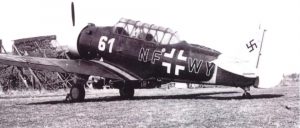
German Crash Expansion
Incredibly, the Luftwaffe did not open new pilot schools until 1944. At first, they modified the pilot training program to push more pilots through more quickly. Besides the limited capacity, the Luftwaffe training program failed to make use of the expertise of fighter aces. They were kept on station until they were killed or wounded. This is one reason that German aces racked up higher scores than Allied aces who were rotated. This had predictable results. Not only were cadets lost in the training program, but the new pilots produced had to face effectively trained Allied pilots in increasingly capable aircraft. The Luftwaffe training program by 1944 was severely impaired by increasing shortages of aviation fuel. There were still planes available in the last phase of the War, but the Luftwaffe had difficulty finding competent pilots. During the Battle of Britain, the RAF had to send out pilots with minimal training–many of who did not survive their first few sorties. By the end of the War, the Luftwaffe was throwing pilots into battle with minimal training.
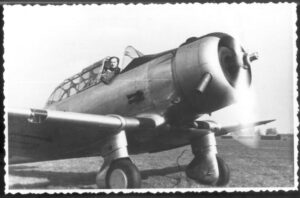
Below – I Had added this because incredibly, Jorg Czypionka in the above picture was an NA-64 pilot and instructor for the Luftwaffe who went on to fly the ME 262 and below he can be seen post-war giving the legendary pilot Eric Winkle Brown a lesson on the ME262 before he took it up for a flight.

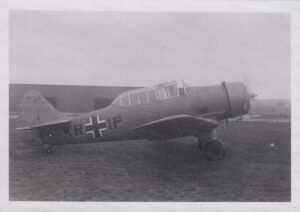
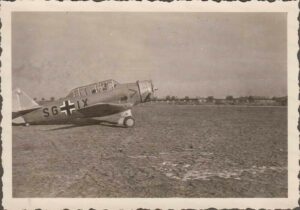
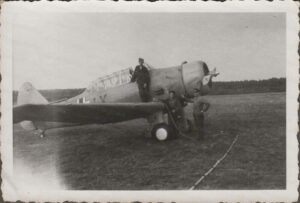
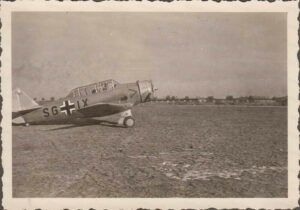
\